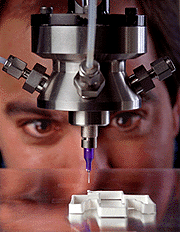Robocasting: Joe Cesarano develops breakthrough way of fabricating ceramics
Sandia engineer Joe Cesarano (1831) has developed a revolutionary new way of fabricating ceramics that requires no molds or machining.
Called robocasting, it relies on robotics for computer-controlled deposition of ceramic slurries –mixtures of ceramic powder, water, and trace amounts of chemical modifers– through a syringe. The material, which flows like a milkshake even though the water content is only about 15 percent, is deposited in thin sequential layers onto a heated base.

Download 150dpi JPEG image, ‘lens_pix.jpg’, 1 Mb
"Layer by layer the part grows before your eyes," Joe says. "The robot squeezes the slurry out of the syringe, almost like a cake decorator, following a pattern prescribed by computer software."
Sandia initially developed the layering technique, LENS TM (Laser Engineered Net Shaping), for the freeform fabrication of metals. This is the first use in the manufacture of ceramics.
Because the new method allows a dense ceramic part to be free-formed, dried, and baked in less than 24 hours, it is perfect for rapid prototyping. Engineers can quickly change a design of a part and physically see if it works.
More traditional ceramic fabrication methods may take weeks to go from a design to an actual part. For example, the standard dry pressing method requires ceramic powder to be compacted into a solid hunk of material, a billet. To fabricate a complicated part, the billet must be sculpted into the final shape with costly machining.
Other ceramic processing techniques, such as slip casting, gel casting, and injection molding, can yield complicated ceramic parts but require the design and manufacture of molds prior to fabrication.
The challenge in robocasting, Joe says, is in the science of developing ceramic slurries that actually contain more solid than liquid but exhibit a fluidlike consistency and flow.
"By understanding the colloid science and manipulating the powder surface chemistry, we are able to make ceramic slurries that are up to 85 percent ceramic powder and 15 percent water," Joe says. "The high solid content minimizes the amount of drying and shrinkage."
The right slurry properties are also essential for rapid drying of the material. Within 10 to 15 seconds of being deposited, the slurry must dry from a fluidlike state into a solidlike state so that the next layer can be added. If the slurry is too fluid, the deposits will come out as liquid beads that spread uncontrollably. If it is too thick, deposits are like rope. With the proper consistency, each deposited bead is a rectangular cross section with relatively straight walls and flattened tops. Such a structure becomes a sound foundation upon which more layers can be deposited.
‘Densifying’ particles
After the part is formed by layering and completely dried, it is baked in a furnace at very high temperatures so that the particles can "densify," a process called sintering. Sintering temperatures typically range from 1,000-1,700 degrees C for two hours, depending on the specific ceramic being sintered.
Joe says robocasting is "no more conceptually complicated than caulking a bathtub." The difference is that when caulking a tub, the caulking gun moves as it deposits the material. In robocasting, the syringe stays in the same position and the base moves.
Robocasting has other virtues besides requiring limited machining and no molds, and being able to make complex parts in less than 24 hours.
"Unlike the more traditional methods of ceramics fabrication, this has the advantage of being able to apply more than one material at a time," Joe says. "Thus, materials can be graded, for example going from a ceramic material to a metal within one part without causing structural damage."
Another positive feature is that the technique enables the discrete placing of a "fugitive" material — material that would evaporate or burn away during the baking process. This is useful for creating a part that has internal structure — cooling channels, for example.
One problem to overcome
The one problem Joe still has to overcome is making a smooth-surfaced final product, comparable to parts with a machined finish. He anticipates he will do this by developing computer models to predict optimal build conditions and monitoring what is being built through laser imaging. The information from the laser image would be fed back to the computer to change the build parameters as the part is being fabricated.
Joe has been researching the new technology for about two-and-a-half years, collaborating with University of Arizona Professor Paul Calvert.
Joe’s research initially focused on the areas of gel casting and processing of ceramics from highly concentrated slurries, while Calvert’s was in freeform fabrication of polymers. Combining the two research areas seemed like a natural transition, Joe says.
‘Some lucky breaks’
He adds that like most research, he had some "lucky breaks with the original developments" and significant contributions from other 1831 personnel, including Bruce King, a post doc, and student interns Hugh Denham and Rachel Segalman.
Joe is in his third year of Laboratory-Directed Research and Development (LDRD) funding for development of the robocasting method.
Last April Joe wrote an article on this new method of ceramics manufacturing in the publication Ceramic Industry. The article generated considerable attention. Twenty companies inquired about the technique. He currently is working with one company, prototyping a ceramic part for use in fabricating fiber optics for advanced X-ray diffraction applications.
However, he says, the ceramics industry is generally taking a guarded approach to the new process.
"The audience response has been filled with intrigue and interest, but they are not yet convinced it can be of great value," he says.
"Our goal is to make parts that visually will convince people this is a revolutionary process."